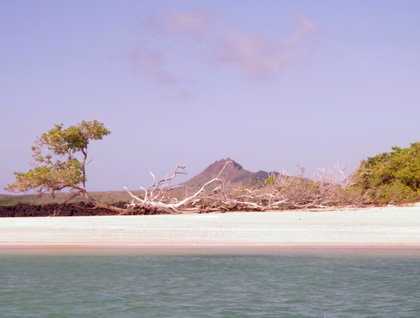This morning we dropped anchor at Cerro Dragon located on the northern part of Santa Cruz Island. This side of the island has never been inhabited due to the lack of water. It was a sunny morning and we started early in order to avoid the heat. Fast paced walkers disembarked first, and natural history groups followed soon afterwards. The disembarkation area is very rocky, and we have to concentrate where we put our step, but soon we were all ashore and ready to explore the surroundings of this unique visitor’s site. Marine iguanas lay all around us, camouflaged very well by the lava rocks. Behind this area there is a brackish water lagoon, where we observed one greater flamingo, which is not a common sight as there are few flamingos in the Galapagos archipelago. We headed inland, fascinated by the vegetation—big prickly pear cacti were covered by thick and long thorns, and the plants were in flower due to the recent light rain in this area. What a delight! The Galapagos flowers are small but beautiful, the predominant colors being white and yellow.
Darwin finches and Galapagos mockingbirds were happily feasting on the abundance of soft seeds—we could observe them very closely, and we felt fortunate that even these little birds were not afraid of humans!
Farther into the trail we found Galapagos land iguanas, including several males who were in search of food, which consists mainly of fresh green leaves and Castela’s berries. Several land iguanas were looking for shade, and from time to time a gentle cool breeze offered some relief from the heat of the Equator! Several clouds gathered on the higher part of Santa Cruz, and headed back.
There is a great snorkeling site in this area known as Guy Fawkes Islets, and deep water snorkeling was offered shortly after our hikes. Suddenly it became very windy, so we went snorkeling in a protected area on the side of the islet, unaffected by the current and wind. Our guests got to see large schools of colorful fish, and even a young Galapagos shark.
We returned to the ship for a delicious Ecuadorian lunch, while the National Geographic Endeavour was repositioned towards Eden Islet. Here we enjoyed a great Zodiac ride, watching as brown pelicans fished and brown noddies tried to steal tiny fish from the beaks of the pelicans, it was awesome. The landscape around Eden Islet is breathtaking!
Later in the afternoon, our young explorers had the chance to take Zodiac riding lessons. Onboard, we had some time to relax or to watch a very interesting movie about the research done on Daphne major islet by British scientists Peter and Rosemary Grant. The Grants have color-banded Darwin finches since 1972, and they have documented every little change that they have discerned, making this one of the best studies of land birds on earth.
Before sunset we circumnavigated Daphne Major islet, a spectacular tuff cone formation, while enjoying wine tasting. This day was awesome, but it was not over yet. After dinner, Paul Vergara, one of our Natural History staff members, led us in a star-gazing activity—here at the Equator we are fortunate enough to see the constellations from both the northern and the southern hemisphere at the same time. A great day came to an end with a gorgeous finale!







